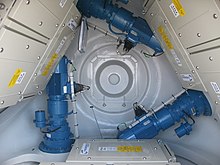Pitch (aerodynamics)
The English term pitch (German: slope, inclination, angle of inclination) denotes
- in aviation or the language of pilots, the movement of an aircraft around the transverse axis (German: nod) or the angle of inclination to the horizontal, see roll-pitch-yaw angle and aircraft control .
- In aerodynamic applications, the angle of attack of the propeller or rotor :
- In propeller-driven aircraft , the pitch of the rotor blades is adjusted in order to achieve the best possible propulsion
- In helicopters , the pitch lever controls the collective angle of attack of the rotor blades and thus the vertical acceleration, i.e. the rise and fall of the helicopter. The mechanical implementation is usually done by a vertical displacement of the swash plate on the main rotor shaft .
In the case of electrically powered vertical starters, for example in model construction, the term is usually also used for the corresponding control direction if this is only implemented by changing the speed of the (electric) motor. - In modern wind power plants (WKA) the pitch of the rotor blades is automatically adjusted in order to regulate the performance of the plant and to optimize its efficiency with changing wind speeds. As a result, the wind turbine can be operated constantly at its nominal output at wind speeds between around 12 m / s and 25 m / s (see: WKA # type class (wind class) ). Above the nominal wind speed , the pitch is increased in order to limit the power consumption and the load on the system. At very high wind speeds (typically 25–33 m / s), the rotor blades are turned completely into the flag position (= "turned into the wind"), whereby the lift is interrupted and the rotor comes to a standstill. This also prevents damage from hurricane gusts.
Individual evidence
- ↑ Power limitation and regulation . Federal Wind Energy Association . Retrieved June 9, 2013.

